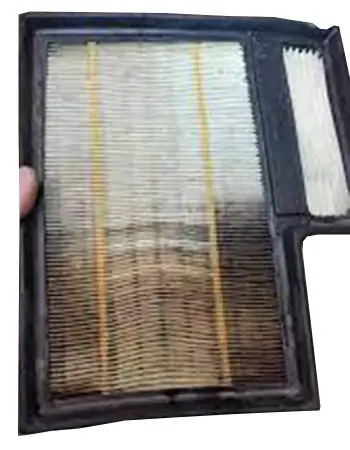What to Check After Driving Through Water
If you drove through deep water, stop immediately and check these items
Driving through water can cause catastrophic engine damage. If your engine died during the plunge, do NOT try and start it until you check these items.
Check the air filter after driving through water
Most cars and trucks made in the 90’s and later have cold air intake systems that draw air from low areas behind the front grille. When you drive through high water, the cold air intake can suck water up into the air filter box. If it sucks in enough water, it can cause the paper air filter to disintegrate, allowing water into the combustion chambers. Since water doesn’t compress, it can “hydrolock” your engine and damage pistons and break valves.
That’s why it’s so important to not try starting the engine until you’ve check the air filter.
Check the air filter
Is it wet?
If yes, then it sucked in water (skip down to “If the air filter is wet”).
 If it’s not wet and there’s no water inside the air filter box, then your engine isn’t at risk for hydrolcok.
If it’s not wet and there’s no water inside the air filter box, then your engine isn’t at risk for hydrolcok.
If the air filter is wet
Check for signs of water in the air duct between the air filter box and the throttle body. If you find evidence of water, there’s a good chance it got into the engine. Do NOT TRY AND START YOUR ENGINE. Call a tow truck and have it checked out by a shop.
So you should immediately check these items before pro
Check for water inside the cabin
If you drove through water that was high enough to enter the cabin and soak your carpet, chances are you’re going to have electrical problems. Do NOT start the vehicle. Have it towed to a shop.
The shop should check the following items after driving through water:
• Water in the starter
• Water in the differential and transmission
• Water in the alternator, fuse box, wiring harness
• Full battery and charging system test.
• Damage to engine splash guards
If all that checks out, the shop should test drive the vehicle to check engine, transmission, and braking operation.
How to deal with a wet interior
Water inside the cabin can cause serious electrical and mold issues. Flood water contains all kinds of contaminates like oil, acids and salt that can damage circuit boards, motors and wiring. If you have water in the cabin, you must treat this as a flooded vehicle. For step-by-step instructions on how to deal with a flooded vehicle, see this article
In almost all cases of water intrusion into the cabin, you’ll have to remove the seats, carpet and padding to dry out the interior. A vacuum will not get the water out of the padding!
©, 2023 Rick Muscoplat
Posted on by Rick Muscoplat